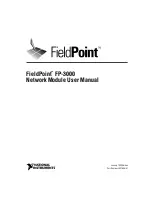
Optimizing Traffic Flow with Port Controls, Port Trunking, and Port-Based Priority
Port Trunking
Table 10-7.
LACP Port Status Data
Status Name
Meaning
Port Numb
Shows the physical port number for each port configured for LACP operation (C1, C2, C3 . . .). Unlisted
port numbers indicate that the missing ports are assigned to a static Trunk group, an FEC trunk group,
or are not configured for any trunking.
LACP Enabled
Active:
The port automatically sends LACP protocol packets.
Passive:
The port does not automatically send LACP protocol packets, and responds only if it receives
LACP protocol packets from the opposite device.
A link having either two active LACP ports or one active port and one passive port can perform dynamic
LACP trunking. A link having two passive LACP ports will not perform LACP trunking because both ports
are waiting for an LACP protocol packet from the opposite device.
Note:
In the default switch configuration, all ports are configured for passive LACP operation.
Trunk Group
Trk
X
: This port has been manually configured into a static LACP trunk.
Trunk Group Same as Port Number:
The port is configured for LACP, but is not a member of a port trunk.
Port Status
Up:
The port has an active LACP link and is not blocked or in Standby mode.
Down:
The port is enabled, but an LACP link is not established. This can indicate, for example, a port that
is not connected to the network or a speed mismatch between a pair of linked ports.
Disabled:
The port cannot carry traffic.
Blocked:
LACP, STP, or FEC has blocked the port. (The port is not in LACP Standby mode.) This may be
due to a trunk negotiation (very brief) or a configuration error such as differing port speeds on the same
link or attempting to connect the switch to more than six trunks.
Standby:
The port is configured for dynamic LACP trunking to another device, but the maximum number
of ports for the Dynamic trunk to that device has already been reached on either the switch itself or the
other device. This port will remain in reserve, or “standby” unless LACP detects that another, active link
in the trunk has become disabled, blocked, or down. In this case, LACP automatically assigns a Standby
port, if available, to replace the failed port.
LACP Partner
Yes:
LACP is enabled on both ends of the link.
No:
LACP is enabled on the switch, but either LACP is not enabled or the link has not been detected on
the opposite device.
LACP Status
Success:
LACP is enabled on the port, detects and synchronizes with a device on the other end of the
link, and can move traffic across the link.
Failure:
LACP is enabled on a port and detects a device on the other end of the link, but is not able to
synchronize with this device, and therefore not able to send LACP packets across the link. This can be
caused, for example, by an intervening device on the link (such as a hub), a bad hardware connection,
or if the LACP operation on the opposite device does not comply with the IEEE 802.3ad standard.
10-28
Содержание ProCurve 6108
Страница 2: ......
Страница 18: ... This page is intentionally blank xvi ...
Страница 50: ...Using the Menu Interface Where To Go From Here This page is intentionally unused 3 16 ...
Страница 110: ...Switch Memory and Configuration Using Primary and Secondary Flash Image Options This page is intentionally unused 6 20 ...
Страница 300: ...Port Based Virtual LANs VLANs and GVRP GVRP This page is intentionally unused 12 48 ...
Страница 432: ...IP Routing Features Configuring DHCP Relay This page is intentionally unused 16 24 ...
Страница 522: ...Troubleshooting Restoring a Flash Image This page is intentionally unused C 44 ...
Страница 528: ...MAC Address Management Determining MAC Addresses This page is intentionally unused D 6 ...
Страница 532: ...Daylight Savings Time on HP ProCurve Switches This page is intentionally unused E 4 ...
Страница 546: ... This page is intentionally unused 14 Index ...
















































